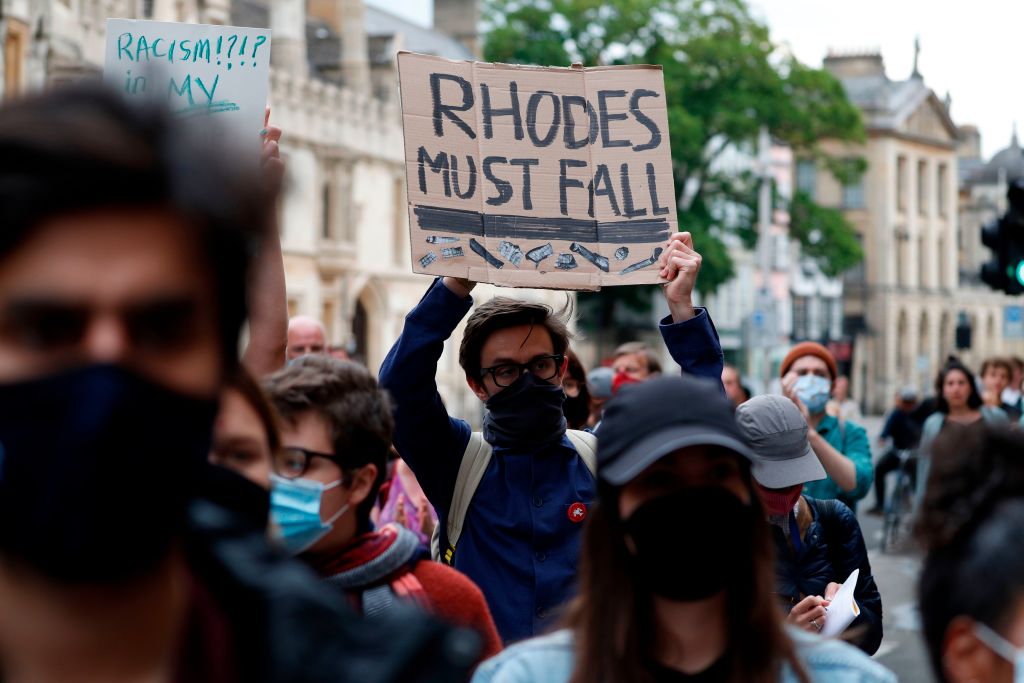Robert Jenrick’s pledge to protect monuments and statues from mob iconoclasm with new laws and powers is very welcome. It’s an issue on which the Government has been quiet in terms of legislation, even if the Prime Minister made clear last summer that ‘we cannot try to edit or censor our past’.
Now that the initial wave of Black Lives Matter activism has subsided, it’s essential to stop left-wing councils from renaming our streets, removing public monuments or, worse still, hanging a badge of opprobrium on them. There is more going on here than many realise: Policy Exchange’s History Matters Project, which is chaired by Trevor Phillips, has so far documented more than 160 cases of history at risk of erasure, from statues to street names, and parts of school and university curricula.
As Jenrick points out, much of this has been rushed through without democratic consultation or due process. The toppling of Edward Colston’s statue in Bristol began the wave of assaults, removing a figure who, whatever his considerable faults, did more than anyone else to fund the city of Bristol. His ownership of slaves was cited as the justification, regardless of the eighteenth century context in which slavery was ubiquitous, with African, Arab and Indian slavers leading the way. This, of course, doesn’t make it right. But it is vital that we see all historical figures, Colston included, as figures of their time, not ours.
Yet Colston is far from alone in being erased. The British Museum demoted the statue of its chief benefactor for similar associations. Guy’s Hospital followed suit, and Oriel College, Oxford, caved in to mob pressure to back the removal its statue of Cecil Rhodes, the Southern African magnate who had endowed so much of Oxford.
Abusive graffiti followed on statues of someone as revered as Winston Churchill, and there was a preposterous demand that even London’s most famous monument, Nelson’s Column, be removed. The popular historian William Dalrymple proposed that statues of Robert Clive, founder of India’s British Raj, should be mothballed in a new museum of colonialism, no doubt a sin-bin to be curated by him. There was no attempt to present a historical context in which Clive, as a self-made man persecuted by snobbish Whig aristocrats and driven to suicide, is very much a hero for our times.
Scottish Nationalist-led Edinburgh City Council then weighed in by attaching a derogatory plaque to their statue of the East India Company Chairman and Whig politician Henry Dundas. Edinburgh Castle followed suit by removing the word ‘heroic’ from a memorial to Scottish soldiers who died during the Indian mutiny, because one visitor with Indian heritage had complained. Ealing’s Labour council then quickly re-named Havelock Street, once honouring another former hero of the Indian Mutiny, after the founding guru of Sikhism.
The common factors in this continuing wave of defenestrations have been any connections with the transatlantic slave trade or with British colonial rule, often wrongly attributing one to the other. What such self-righteous, puritanical zeal has ignored is the uncomfortable fact that slavery was almost universally practised across the globe until the British empire and navy stamped it out in the mid-19th century. Today, Nigeria leads the world with the horrifying figure of over a million people in modern slavery. Surely this is a better target for our anger than statues of long-dead people like Colston?
Equally neglected has been the historical reality that British imperial rule, whether by Clive or his successors, was almost invariably preferred to indigenous alternatives by the populations they ruled. But empire, the world’s default form of government for millennia, is no longer fashionable, while nation-states are, despite their record of ethnic cleansing. So does that legitimise demonising all our past imperial icons, and where should we draw the line – with Queen Victoria, first Empress of India, or beyond?
Jenrick promises that such dilemmas will, under his proposed new legislation, be resolved by proper public consultation by local authorities, with himself as Secretary of State retaining reserve powers to intervene. While such rules may slow down the process, will they resolve genuine differences of opinion, and can local public opinion be expected to master all the historical niceties, especially when historian themselves disagree? What Policy Exchange has documented suggests the Secretary of State may soon find himself inundated with absurd and ahistorical requests to remove statues and rename streets all over the country.
Jenrick has advocated ‘explaining or contextualising’ monuments. But if this takes the form of writing apologetic or condemnatory plaques for controversial figures, might this become an exercise in imposing our own 21st century moral judgements on them? Is it fair or ethical to retain the philanthropy of benefactors like Cecil Rhodes or Thomas Guy, but affix a badge of shame on the statues honouring them?
These are ethical and historical questions that any new planning process will need to address. The Government already has the power to intervene in the case of listed monuments like the Rhodes statue. The legislation promised by Jenrick will further scrutinise local changes in our public spaces. The rule of thumb will probably be to retain the status quo when in doubt. But will this also halt the prevailing fashion among the trustees of private charities like our museums, schools, colleges and hospitals to surrender to left-liberal iconoclasm in the name of that weasel-word diversity? The remarkably petty decision this month by Merchant Taylors’ School to rename its Clive House suggests otherwise.
Dr Zareer Masani is a historian and is on the advisory panel of Policy Exchange’s History Matters Project






Comments